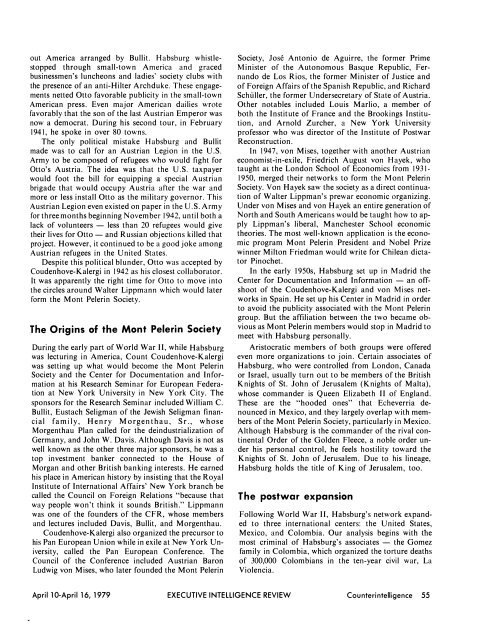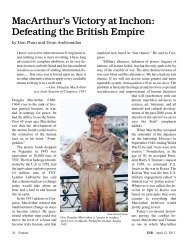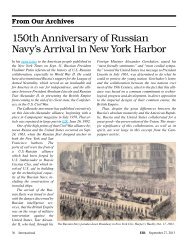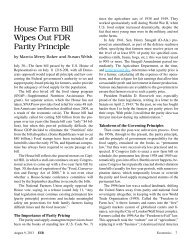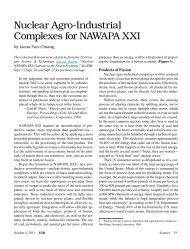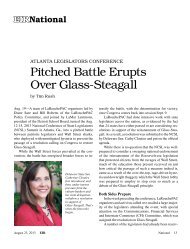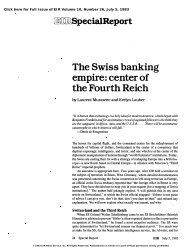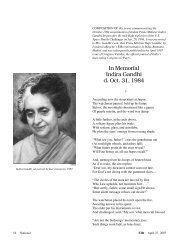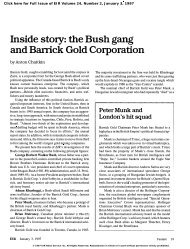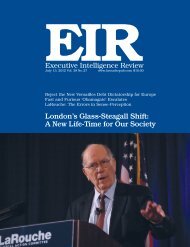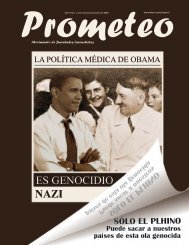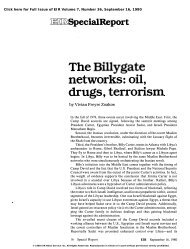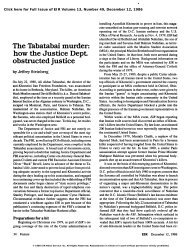Who is Otto von Habsburg? - Executive Intelligence Review
Who is Otto von Habsburg? - Executive Intelligence Review
Who is Otto von Habsburg? - Executive Intelligence Review
Create successful ePaper yourself
Turn your PDF publications into a flip-book with our unique Google optimized e-Paper software.
out America arranged by Bullit. <strong>Habsburg</strong> wh<strong>is</strong>tle<br />
stopped through small-town America and graced<br />
businessmen's luncheons and ladies' society clubs with<br />
the presence of an anti-Hilter Archduke. These engage<br />
ments netted <strong>Otto</strong> favorable publicity in the small-town<br />
American press. Even major American dailies wrote<br />
favorably that the son of the last Austrian Emperor was<br />
now a democrat. During h<strong>is</strong> second tour, in February<br />
1941, he spoke in over 80 towns.<br />
The only political m<strong>is</strong>take <strong>Habsburg</strong> and Bullit<br />
made was to call for an Austrian Legion in the U. S.<br />
Army to be composed of refugees who would fight for<br />
<strong>Otto</strong>'s Austria. The idea was that the U.S. taxpayer<br />
would foot the bill for equipping a special Austrian<br />
brigade that would occupy Austria after the war and<br />
more or less install <strong>Otto</strong> as the military governor. Th<strong>is</strong><br />
Austrian Legion even ex<strong>is</strong>ted on paper in the U.S. Army<br />
for three months beginning November 1942, until both a<br />
lack of volunteers - less than 20 refugees would give<br />
their lives for <strong>Otto</strong> - and Russian objections killed that<br />
project. However, it continued to be a good joke among<br />
Austrian refugees in the United States.<br />
Despite th<strong>is</strong> political blunder, <strong>Otto</strong> was accepted by<br />
Coudenhove-Kalergi in 1942 as h<strong>is</strong> closest collaborator.<br />
It was apparently the right time for <strong>Otto</strong> to move into<br />
the circles around Walter Lippmann which would later<br />
form the Mont Pelerin Society.<br />
The Origins of the Mont Pelerin Society<br />
During the early part of World War II, while <strong>Habsburg</strong><br />
was lecturing in America, Count Coudenhove-Kalergi<br />
was setting up what would become the Mont Pelerin<br />
Society and the Center for Documentation and Infor<br />
mation at h<strong>is</strong> Research Seminar for European Federation<br />
at New York University in New York City. The<br />
sponsors for the Research Seminar included William C.<br />
Bullit, Eustach Seligman of the Jew<strong>is</strong>h Seligman finan<br />
cial family, Henry Morgenthau, Sr., whose<br />
Morgenthau Plan called for the deindustrialization of<br />
Germany, and John W. Dav<strong>is</strong>. Although Dav<strong>is</strong> <strong>is</strong> not as<br />
well known as the other three major sponsors, he was a<br />
top investment banker connected to the House of<br />
Morgan and other Brit<strong>is</strong>h banking interests. He earned<br />
h<strong>is</strong> place in American h<strong>is</strong>tory by ins<strong>is</strong>ting that the Royal<br />
Institute of International Affairs' New York branch be<br />
called the Council on Foreign Relations "because that<br />
way people won't think it sounds Brit<strong>is</strong>h." Lippmann<br />
was one of the founders of the CFR, whose members<br />
and lectures included Dav<strong>is</strong>, BuIIit, and Morgenthau.<br />
Coudenhove-Kalergi also organized the precursor to<br />
h<strong>is</strong> Pan European Union while in exile at New York Un<br />
iversity, called the Pan European Conference. The<br />
Council of the Conference included Austrian Baron<br />
Ludwig <strong>von</strong> M<strong>is</strong>es, who later founded the Mont Pelerin<br />
Society, Jose Antonio de Aguirre, the former Prime<br />
Min<strong>is</strong>ter of the Autonomous Basque Republic, Fer<br />
nando de Los Rios, the former Min<strong>is</strong>ter of Justice and<br />
of Foreign Affairs of the Span<strong>is</strong>h Republic, and Richard<br />
Schiiller, the former Undersecretary of State of Austria.<br />
Other notables included Lou<strong>is</strong> Marlio, a member of<br />
both the Institute of France and the Brookings Institu<br />
tion, and Arnold Zurcher, a New York University<br />
professor who was director of the Institute of Postwar<br />
Reconstruction.<br />
In 1947, <strong>von</strong> M<strong>is</strong>es, together with another Austrian<br />
econom<strong>is</strong>t-in-exile, Friedrich August <strong>von</strong> Hayek, who<br />
taught ai the London School of Economics from 1931-<br />
1950, merged their networks to form the Mont Pelerin<br />
Society. Von Hayek saw the society as a direct continua<br />
tion of Walter Lippman's prewar economic organizing.<br />
Under <strong>von</strong> M<strong>is</strong>es and <strong>von</strong> Hayek an entire generation of<br />
North and South Americans would be taught how to ap<br />
ply Lippman's liberal, Manchester School economic<br />
theories. The most well-known application <strong>is</strong> the econo<br />
mic program Mont Pelerin President and Nobel Prize<br />
winner Milton Friedman would write for Chilean dicta<br />
tor Pinochet.<br />
In the early 1950s, <strong>Habsburg</strong> set up in Madrid the<br />
Center for Documentation and Information - an off<br />
shoot of the Coudenhove-Kalergi and <strong>von</strong> M<strong>is</strong>es net<br />
works in Spain. He set up h<strong>is</strong> Center in Madrid in order<br />
to avoid the pUblicity associated with the Mont Pelerin<br />
group. But the affiliation between the two became ob<br />
vious as Mont Pelerin members would stop in Madrid to<br />
meet with <strong>Habsburg</strong> personally.<br />
Ar<strong>is</strong>tocratic members of both groups were offered<br />
even more organizations to join. Certain associates of<br />
<strong>Habsburg</strong>, who were controlled from London, Canada<br />
or Israel, usually turn out to be members of the Brit<strong>is</strong>h<br />
Knights of St. John of Jerusalem (Knights of Malta),<br />
whose commander <strong>is</strong> Queen Elizabeth II of England.<br />
These are the "hooded ones" that Echeverria de<br />
nounced in Mexico, and they largely overlap with mem<br />
bers of the Mont Pelerin Society, particularly in Mexico.<br />
Although <strong>Habsburg</strong> <strong>is</strong> the commander of the rival con<br />
tinental Order of the Golden Fleece, a noble order un<br />
der h<strong>is</strong> personal control, he feels hostility toward the<br />
Knights of St. John of Jerusalem. Due to h<strong>is</strong> lineage,<br />
<strong>Habsburg</strong> holds the title of King of Jerusalem, too.<br />
The postwar expansion<br />
Following World War II, <strong>Habsburg</strong>'s network expand<br />
ed to three international centers: the United States,<br />
Mexico, and Colombia. Our analys<strong>is</strong> begins with the<br />
most criminal of <strong>Habsburg</strong>'s associates - the Gomez<br />
family in Colombia, which organized the torture deaths<br />
of 300,000 Colombians in the ten-year civil war, La<br />
Violencia.<br />
April 10-April 16, 1979 EXECUTIVE INTELLIGENCE REVIEW Counterintelligence 55


